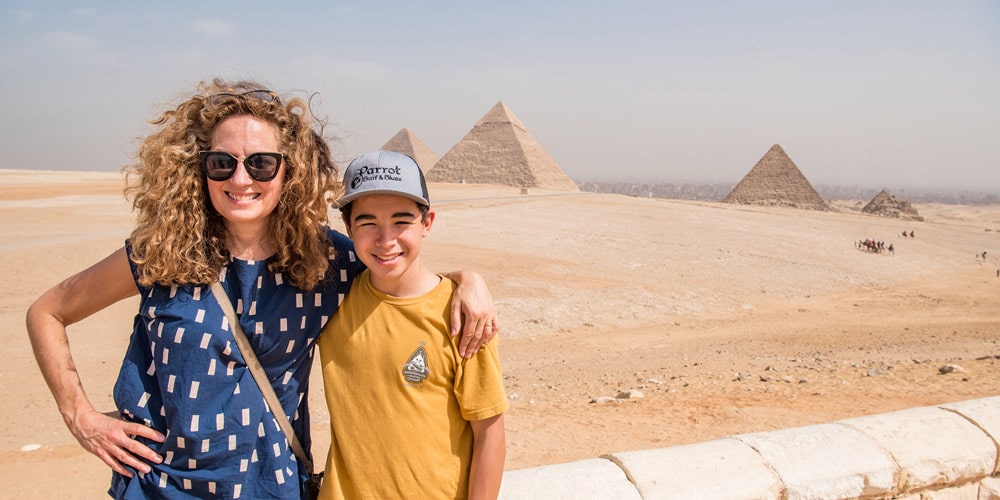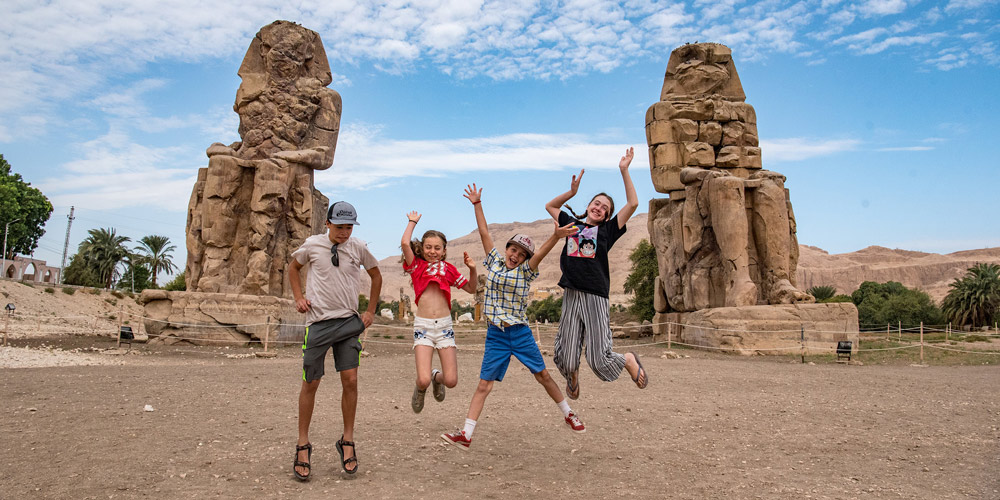
With the Egyptian sun setting over the Nile, my 14-year-old son and his two new friends used a flashlight to build a makeshift kite on the upper deck of our felucca boat. There was no wind to power the kite — or, for that matter, our sails — but these tech-obsessed kids were flush with the excitement of making a rudimentary toy out of two sticks, a square of plastic and a length of twine.
With the colored lights of nearby Aswan reflecting on the water, mothers and children then savored a delicious stew cooked on board by a three-man Nubian crew. Strangers to each other just a few days earlier, we broke bread, talked and laughed together, enjoying the simple pleasure of dinner under the stars.
Our group was taking part in one of Intrepid Travel‘s new “solo parent” adventure trips, also offered in India, Vietnam, Morocco, Thailand and Costa Rica. Ranging in length from 8 to 15 days, the excursions are designed for one parent or grandparent – divorced, widowed, or partnered with someone who can’t get away – and kids ages 5 to 17.

Our little travel group was made up of six mothers, hailing from the US, England and Australia, and their boys and girls (ranging in age from 5-14). We were accompanied by an Egyptian guide, Walid, and a few Intrepid employees.
Although I had spent a few weeks in Egypt two decades ago and recommend it to everyone, I did wonder whether it was safe to take my son there. A quick look at the U.S. Department of State web site reassured me. The travel advisory was Level 2 (“exercise increased caution”), the same as for France and Germany. I would go to either of those European countries without hesitation, I reasoned, so why avoid Egypt? I made sure to dress modestly by Islamic standards – shoulders and knees covered, nothing low cut – and felt secure the entire time.
From our arrival dinner at a terraced Cairo restaurant, we knew we would have fun with this crew. The grownups hit it off immediately, trading work, vacation and personal stories, and depending on the smart Coloradan mom who packed a pharmacy’s worth of medication for every imaginable ailment. Most of the mothers were separated (as I had recently become) or divorced, and conversations inevitably strayed to the breakdown of relationships and dating. Despite our geographical diversity and age differences, we had a lot in common and it was both edifying and comforting to hear how these enterprising women had rebuilt their lives.
The little ones bonded quickly and proved to be surprisingly unwhiny explorers, inventing games on the longer drives and modeling bedazzled Cleopatra costumes purchased at street markets. It took the standoffish teens a day, a deck of cards and an overnight train from Cairo to Aswan to start talking. The kids were game for meandering the chaotic souks and tasting new foods (to my amazement, my son ordered – and ate – a stuffed pigeon). By the end, all the children were dancing around the Cairo Novotel pool together and chasing each other through the lobby.

Our action-packed September expedition started under a blazing sun in Cairo. We visited the Pyramids of Giza and the Sphinx, marvels of ancient engineering, then toured the Egyptian Museum’s fabled Royal Mummies Hall and King Tutunkhamun’s glittering treasures. “It was cool seeing King Tut’s gold death mask because we studied it in sixth grade and I always wanted to see it in real life,” said my son, who still has the Lego “Pharaoh’s Quest” set he begged for one Christmas.
Next, we took an overnight train to Aswan, where we rode betassled camels through the desert and joined a Nubian family for a traditional dinner in their home. After the multi-course feast, our boys played soccer with the village children in a dirt courtyard between the houses. The impromptu game was one of the highlights of the trip for my son, not least because he scored five goals.
We also took a short round-trip flight from Aswan to Abu Simbel, colossal twin carved-stone temples and statues on the bank of Lake Nasser. The monuments to Pharaoh Ramesses II and his queen Nefertari date to 13th century B.C. and are well worth the detour and extra cost ($100 per person with a minimum of four passengers).

So is an off-tour drink at the Old Cataract, a Colonial-era hotel that has welcomed dozens of dignitaries. Agatha Christie set parts of her novel, Death on the Nile, at the five-star riverfront resort and the 1978 film adaptation was shot there, too. My son loved sipping his exotic fruity drink spiked with mint on the elegant terrace.
While there were a number of other edifices on the itinerary, perhaps the most memorable were the tombs we entered in the Valley of the Kings opposite Luxor. After all, it’s in this desert that Tutankhamun’s underground mausoleum, containing his linen-wrapped mummy and more than 5,000 priceless relics, was discovered by archeologist Howard Carter in 1922. The royal necropolis is still being excavated and new discoveries brought to light.

When we weren’t visiting awe-inspiring monoliths and mythic landscapes, the schedule permitted a few free hours to roam the cities. My son and I drank tea at cafes and wandered the open-air markets in search of an Egyptian chess set for him (we found one with pharaoh kings, headdress-wearing queens, falcon knights and obelisk rooks). It was during one of those outings that unexpected magic happened.
On our last day, we took a taxi back to the hotel from Cairo’s Khan el-Khalili bazaar and realized several minutes into the ride that the ebullient young driver had no idea what I had said or where he was going. As the cab sped along an overpass to a destination unknown, and I tried to pronounce Novotel with my version of an Arabic accent, my son and I looked at each other and started laughing. We were lost, but we were together, so we knew we’d be okay.
By Alev Aktar

